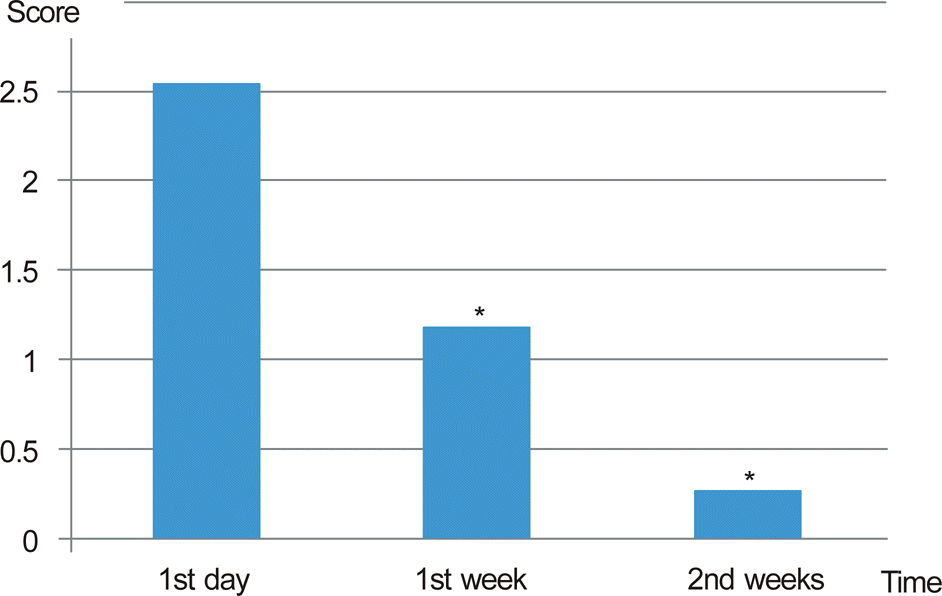Abstract
Purpose
We investigated the efficacy of fibrin glue for conjunctival closure in scleral buckling operations.
Methods
Thirty-seven eyes of 35 patients who underwent conjunctival closure for a scleral buckling operation with a minimum follow-up period of 3 months were evaluated. Postoperative discomfort (average score), presence of remnant adhesives, scleral buckle material infection, and wound dehiscence were evaluated prospectively in 35 eyes of 33 patients undergoing surgery with fibrin glue.
Results
The eyes showed decreasing conjunctival injection and hemorrhage over time and near to full recovered without any treatment after 1 month. With time, the average discomfort score decreased significantly (p < 0.05) and wound dehiscence was found in only 1 eye. There was no adhesive remnant in any of the eyes.
Go to : 
References
1. Kheirkhah A, Casas V, Blanco G. . Amniotic membrane trans-plantation with fibrin glue for conjunctivochalasis. Am J Ophthalmol. 2007; 144:311–3.

2. Straatsma BR, Allen RA, Hale PN, Gomez R. Experimental studies employing adhesive compounds in ophthalmic surgery. Trans Am Acad Ophthalmol Otolaryngol. 1963; 67:320–34.
3. Ellis RA, Levine AM. Experimental sutureless ocular surgery. Am J Ophthalmol. 1963; 55:733–42.
4. Erbil H, Sinav S, Süllü Y, Kandemir B. An experimental study on the use of fibrin sealants in strabismus surgery. Turk J Pediatr. 1991; 33:111–6.
5. Toriumi DM, Raslan WF, Friedman M, Tardy ME. Histotoxicity of cyanoacrylate tissue adhesives. A comparative study. Arch Otolaryngol Head Neck Surg. 1990; 116:546–50.

6. O'Sullivan F, Dalton R, Rostron CK. Fibrin glue: an alternative method of wound closure in glaucoma surgery. J Glaucoma. 1996; 5:367–70.
7. Mandel MA. Closure of blepharoplasty incisions with autologous fibrin glue. Arch Ophthalmol. 1990; 108:842–4.

8. Bartley GB, McCaffrey TV. Cryoprecipitated fibrinogen (fibrin glue) in orbital surgery. Am J Ophthalmol. 1990; 109:227–8.

10. Uy HS, Reyes JM, Flores JD, Lim-Bon-Siong R. Comparison of fi-brin glue and sutures for attaching conjunctival autografts after pterygium excision. Ophthalmology. 2005; 112:667–71.

11. Yoon KC, Heo H, Jeong IY, Park YG. The use of fibrin glue for conjunctival autotransplantation in pterygium. J Korean Ophthalmol Soc. 2006; 47:198–204.
12. Nam KY, Jo YJ, Lee SB. The efficacy of fibrin glue in surgical treatment of conjunctivochalasis with epiphora. J Korean Ophthalmol Soc. 2010; 51:498–503.

13. Cohen RA, McDonald MB. Fixation of conjunctival autografts with an organic tissue adhesive. Arch Ophthalmol. 1993; 111:1167–8.

14. Ordman LJ, Gillman T. Studies in the healing of cutaneous woundsI. The healing of incisions through the skin of pigs. Arch Surg. 1966; 93:857–82.
15. Carlson AN, Wilhelmus KR. Giant papillary conjunctivitis asso-ciated with cyanoacrylate glue. Am J Ophthalmol. 1987; 104:437–8.

16. Spotnitz WD. Fibrin sealant: past, present, and future: a brief review. World J Surg. 2010; 34:632–4.

17. Krzizok T. Fibrin glue for closing conjunctival wounds in oph-thalmic surgery. Ophthalmologe. 2004; 101:1006–10.
Go to : 
 | Figure 1.Wound dehiscence (arrow) at the nasal side after scleral buckling using tissue adhesives. But adhesion was maintained between conjunctiva and sclera. Dehiscence size decreased as time passed and nearly recovered without any treatment after 1 month. |
 | Figure 2.Series of photographs of a patient after scleral buckling using tissue adhesives. The eye showed decreasing conjunctival injection and hemorrhage as time passed and near full recovered without any treatment after 1 month. |
 | Figure 3.Discomfort sign and symptoms (average score) in the patients after scleral buckling using tissue adhesives. As time passed, the average score decreased significantly (* p < 0.05, Wilcoxon's signed-ranks test). |
Table 1.
Baseline characteristics of patients




 PDF
PDF ePub
ePub Citation
Citation Print
Print


 XML Download
XML Download